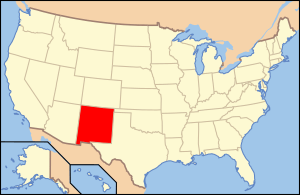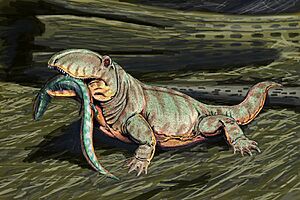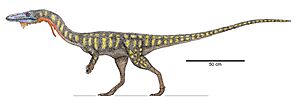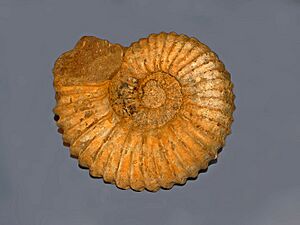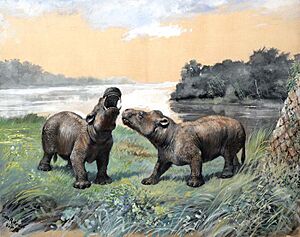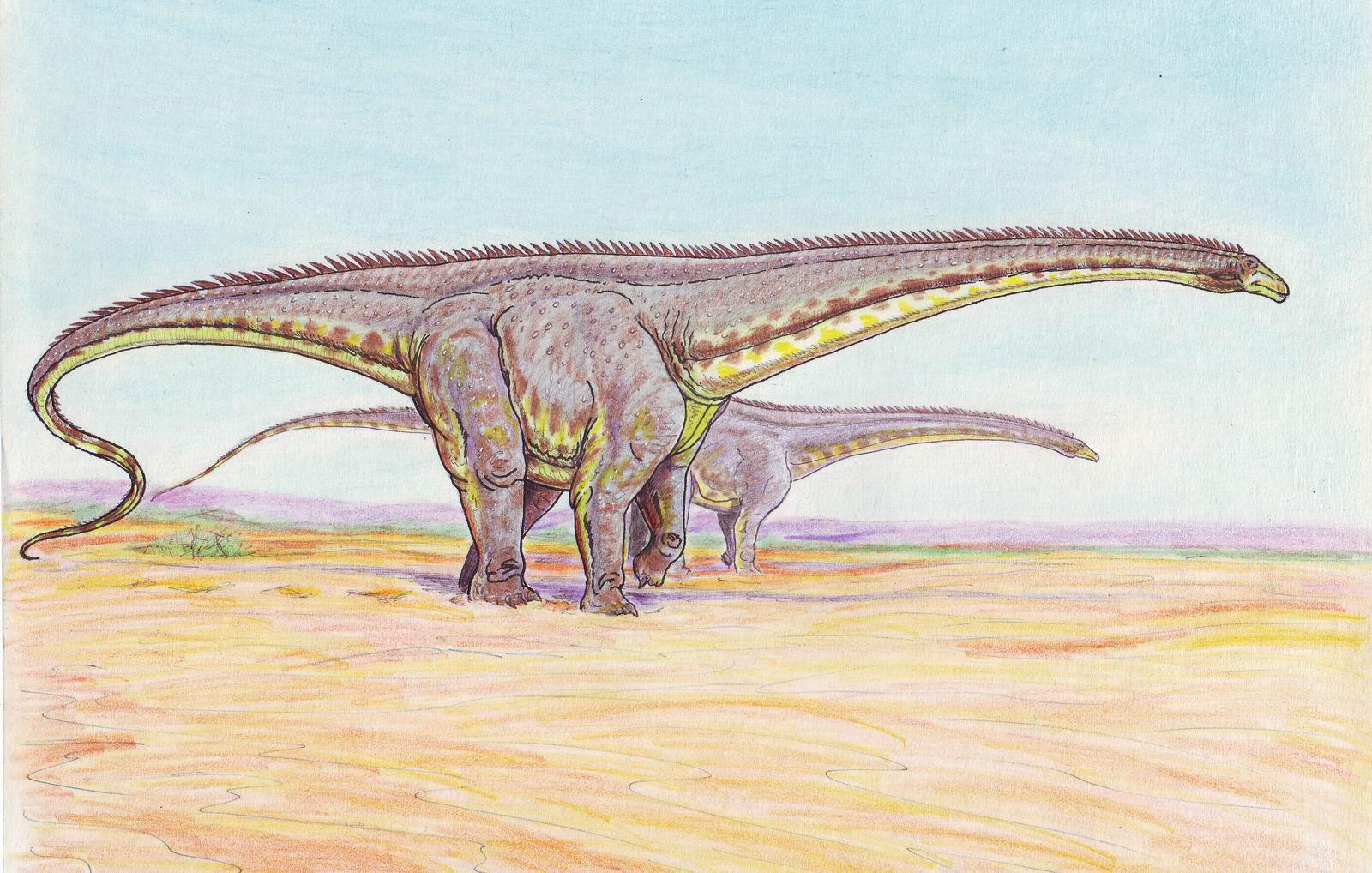Paleontology in New Mexico facts for kids
Paleontology in New Mexico is all about finding and studying fossils in the U.S. state of New Mexico. New Mexico has an amazing collection of fossils that cover almost all of Earth's history! Scientists have found more than 3,300 different kinds of fossil creatures here. Over 700 of these were completely new to science, and more than 100 were so unique they became the main example for new groups of animals.
Millions of years ago, during the early Paleozoic Era, a warm, shallow sea covered southern and western New Mexico. This sea was home to many creatures like brachiopods (shellfish), bryozoans (tiny colonial animals), corals, and trilobites (ancient sea bugs). Huge algal reefs, some as tall as 300 feet, grew in the Ordovician seas. Later, in the Carboniferous Period, islands covered with thick forests appeared. On land, creatures like Edaphosaurus and Sphenacodon roamed.
During the Triassic Period, New Mexico had a climate with wet and dry seasons. Early dinosaurs like Coelophysis lived on lush floodplains. The Jurassic Period was drier, and giant dinosaurs such as Allosaurus, Stegosaurus, and huge long-necked sauropods lived here. In the Cretaceous Period, a sea covered eastern New Mexico, while on land, dinosaurs like tyrannosaurs were still in charge.
As the Cenozoic Era began, New Mexico was swampy, but it slowly got cooler. Animals like early horses, carnivorans (meat-eaters), and the 7-foot-tall flightless bird Diatryma lived here. Eventually, the Ice Age arrived, and mastodons roamed the state.
Long ago, Native Americans created stories to explain the fossil bones and petrified wood they found. Scientists started paying attention to New Mexico's fossils in the mid-1800s. Some big discoveries include the ancient mammal Coryphodon, a preserved mummy of a ground sloth called Nothrotherium, and huge bonebeds of Coelophysis dinosaurs. The Coelophysis dinosaur, specifically Coelophysis bauri, is even New Mexico's official state fossil!
Contents
Ancient Times in New Mexico
New Mexico's fossil story starts in the Paleozoic Era because no fossils from the very first period, the Precambrian, have been found here.
Life in Ancient Seas
During the Late Cambrian Period, the southern part of New Mexico was covered by a shallow sea. This sea was home to creatures like brachiopods, a type of graptolite (small colonial animals), and trilobites. Scientists have also found trace fossils, which are marks left by ancient worms burrowing in the mud.
The sea stayed in southern New Mexico throughout the entire Ordovician Period. More than 200 kinds of sea creatures lived here, including brachiopods, bryozoans, corals, gastropods (snails), nautiloids (shelled squid-like animals), and trilobites. Amazing algae built reefs that were up to 300 feet tall!
Marine conditions continued into the Silurian Period. At least 66 types of sea animals lived here, similar to those from the Ordovician. By the Devonian Period, the seas were not as widespread, but the Sly Gap Formation and Percha Formation in the southwest have excellent fossils. Over 200 kinds of Devonian sea life have been found, including bryozoans, cephalopods (like squid), corals, and gastropods. Importantly, fish also appeared, including armored fish called placoderms and early cartilaginous fishes (like sharks).
Islands and Early Land Animals
During the Carboniferous Period, a chain of islands started to form in New Mexico's shallow sea. The parts of the sea that remained were filled with brachiopods and clams. The islands themselves were covered with thick forests and swamps. In the Mississippian time, creatures like crinoids (sea lilies) built huge underwater mounds called bioherms. The sea was full of life, including many types of brachiopods, corals, and crinoids. On land, primitive plants like horsetails and scale trees grew.
In the Pennsylvanian Period, New Mexico had both sea and land environments. Sea life included many species of brachiopods, bryozoans, cephalopods, and corals. Tiny creatures called foraminiferans were incredibly abundant. On land, about 60 different kinds of plants grew.
As the Permian Period began, the climate became much drier. Rivers dried up, and sand dunes appeared. The sea became very salty. Later in the Permian, the seas returned to normal, and a huge reef system formed in southeastern New Mexico. Over 300 kinds of marine life have been found from this time. On land, early conifers, horsetails, and seed ferns grew. Animals like Aerosaurus, Edaphosaurus, Ophiacodon, and Sphenacodon lived here. Many of their footprints are preserved in ancient mudflats at the Prehistoric Trackways National Monument near Las Cruces.
The Age of Dinosaurs
About 220 million years ago, in the Late Triassic Period, eastern New Mexico was a basin where streams and rivers deposited mud and sand. This buried the remains of plants and animals, creating fossils. The climate was strongly seasonal, meaning it had very wet and very dry times. Freshwater lakes and streams were home to clams, fish, and snails. Lush plants like conifers, cycads, and horsetails grew on the floodplains. The early dinosaur Coelophysis lived here.
The Jurassic Period in New Mexico is not as well known, but it was a relatively dry time with coastal plains. Dinosaurs from the Late Jurassic found in the Morrison Formation include Allosaurus, Stegosaurus, and massive long-necked sauropods.
Eastern New Mexico was covered by sea again during the Cretaceous Period. This sea was home to ammonites (shelled creatures like nautiloids) and oysters. Over 900 different kinds of life are known from New Mexico during the Cretaceous. Many sea invertebrates from the Late Cretaceous were much larger than modern types. Giant snails with shells up to 18 inches across lived here, and the largest ammonite, Mantelliceras canitaurium, had a shell up to 16 inches wide.
On land, many different plants grew, including ferns, figs, honeysuckles, and willows. There were also trees that left behind petrified logs over 30 feet long. Land animals included crocodiles and at least 16 different kinds of turtles. But dinosaurs still ruled! Ceratopsians (horned dinosaurs), Bistahieversor (a type of tyrannosaur), ornithopods, and sauropods lived here.
These dinosaurs left behind many trace fossils (footprints). In Clayton Lake State Park, over 500 dinosaur tracks were found in the Dakota Formation. Another site, Mosquero Creek, has 55 parallel trackways left by ornithopods moving on all fours, and other parallel tracks from even larger two-legged ornithopods. These tracks show that some dinosaurs might have moved in groups, suggesting social behavior.
After the Dinosaurs: The Cenozoic Era
Major geological changes in the early Cenozoic Era created New Mexico's mountains and valleys. The landscape had many rivers and lakes. Garfish lived in the lakes, and magnolias grew in the floodplains. Many volcanic eruptions happened during this time.
During the Paleocene epoch, the Raton area was covered in swamps. Some palm leaves found here were over 9 feet wide! At least 42 different kinds of mammals lived in New Mexico, including early carnivorans and marsupials. Other animals included crocodiles, fish, and turtles.
The Eocene Period in New Mexico has fossils of 120 different animal species. On land, mammals were very diverse, with over 80 species. The Baca Formation in Socorro County has 18 footprints in three parallel trackways. These were likely made by early cloven-hoofed mammals, possibly relatives of camels. These tracks are important because they are among the oldest known fossil footprints from cloven-hoofed mammals and suggest these animals also moved in groups. Another interesting Eocene animal was the 7-foot-tall flightless bird Diatryma.
Not many clear fossils have been found from the Oligocene Period in New Mexico, so this time remains a bit of a mystery. However, the Datil Formation has one of only seven Oligocene fossil track sites in the western United States.
From the Miocene to Pliocene periods, New Mexico was home to relatives of modern elephants with four tusks. There were also many beavers, three-toed horses, and rhinoceroses. Trees from this time have been preserved as petrified wood, some even turning into a gem-like substance called opal.
As the Cenozoic Era continued, the climate got cooler. During the Quaternary Period, the Rio Grande became the main river system. In the Pleistocene epoch (the Ice Age), large trees, probably pines, were preserved as impressions in ancient lava flows. The state's animals included at least 65 kinds of birds, 2 reptiles, and 43 mammals. Camels and mammoths lived here. American mastodon remains were found very high up in the Sandia Mountains, which is the highest place this species has ever been found. Many Ice Age fossils were preserved in local caves.
Discovering New Mexico's Past
Scientific Research and Big Finds
The first written record of fossils in New Mexico was by a trader named Josiah Gregg in 1846, who wrote about petrified wood. Later, in the 1840s, J. W. Abert described fossils like petrified wood, shark teeth, shells, and bones. As plans for the transcontinental railroad were made in the 1850s, geologists found more fossils and sent them to scientists for identification.
Important paleontologists soon became involved. Joseph Leidy described a new mastodon from New Mexico. Edward Drinker Cope became very active, writing 66 papers on New Mexico fossils between 1871 and 1893.
In 1874, Cope came to New Mexico and found the first known Eocene mammal from the southwestern United States, called Coryphodon. He also discovered fossils of camels, crocodiles, deer, dogs, horses, and more mastodons. In total, he found about 90 species, which greatly helped scientists understand this period of American history.
In 1875, the Puerco Formation was discovered, which later became known as one of the best places in the world to find Paleocene fossils. The American Museum of Natural History sent teams in 1892 to uncover more.
In 1928, three boys found a nearly complete, preserved mummy of a ground sloth called Nothrotherium shasetnse deep inside Aden Crater near Las Cruces.
In 1936, R. V. Witter and his wife found fragments of ancient amphibian bones in Santa Fe County. Following the stream, they discovered a huge mass of Triassic amphibian skeletons. They excavated about 100 individual amphibians, even though the site might have held thousands! This find was very important because Triassic amphibian fossils are rare in North America. To protect the fragile fossils, they created a huge plaster cast weighing over a ton to move the block of rock. Scientists believe this bone bed might have formed when a drought dried up water pools, concentrating the amphibians.
In 1947, a team led by Edwin Harris Colbert discovered a huge bonebed with over 1,000 Coelophysis skeletons at Ghost Ranch. Later, in 1953, William Chenoweth found three important dinosaur sites in Morrison Formation rocks, including parts of Allosaurus, sauropods, and Stegosaurus. In 1956, a nine-year-old boy found well-preserved mastodon teeth while looking for Indian arrowheads.
In 1979, two hikers found gigantic fossil vertebrae near San Ysidro. They reported them to David Gilette of the New Mexico Museum of Natural History. Gillette led an expedition that used special technology to find the bones still buried in sandstone. They dug up a huge area and found a large part of the back half of a diplodocid sauropod dinosaur. In 1991, this dinosaur was named Seismosaurus and was thought to be the longest dinosaur ever, at 52 meters (170 feet) long! However, in the 2000s, scientists realized Seismosaurus was actually the same as Diplodocus, a dinosaur already known from the western United States.
In 1989, excavations began at a fossil site discovered by Rodney Peterson near Albuquerque. They found fossils of a huge allosaurid (a type of meat-eating dinosaur) that might be Saurophaganax, Camarasaurus, and parts of a diplodocid. This was the first major site in New Mexico to have many bones from different dinosaur species. Before these discoveries, most dinosaur fossils found in New Mexico were just small pieces found by accident during mining or uranium surveys.
Natural History Museums in New Mexico
If you want to see some of these amazing fossils, you can visit these museums in New Mexico:
- Eastern New Mexico University Natural History Museum, Eastern New Mexico University, Portales
- Las Cruces Museum of Natural History, Las Cruces
- Mesalands Community College's Dinosaur Museum, Tucumcari
- Miles Mineral Museum, Portales
- New Mexico Bureau of Geology and Mineral Resources Museum, Socorro
- New Mexico Museum of Natural History and Science, Albuquerque
- Ruth Hall Museum of Paleontology, Abiquiú
- Sherman Dugan Museum of Geology, Farmington


